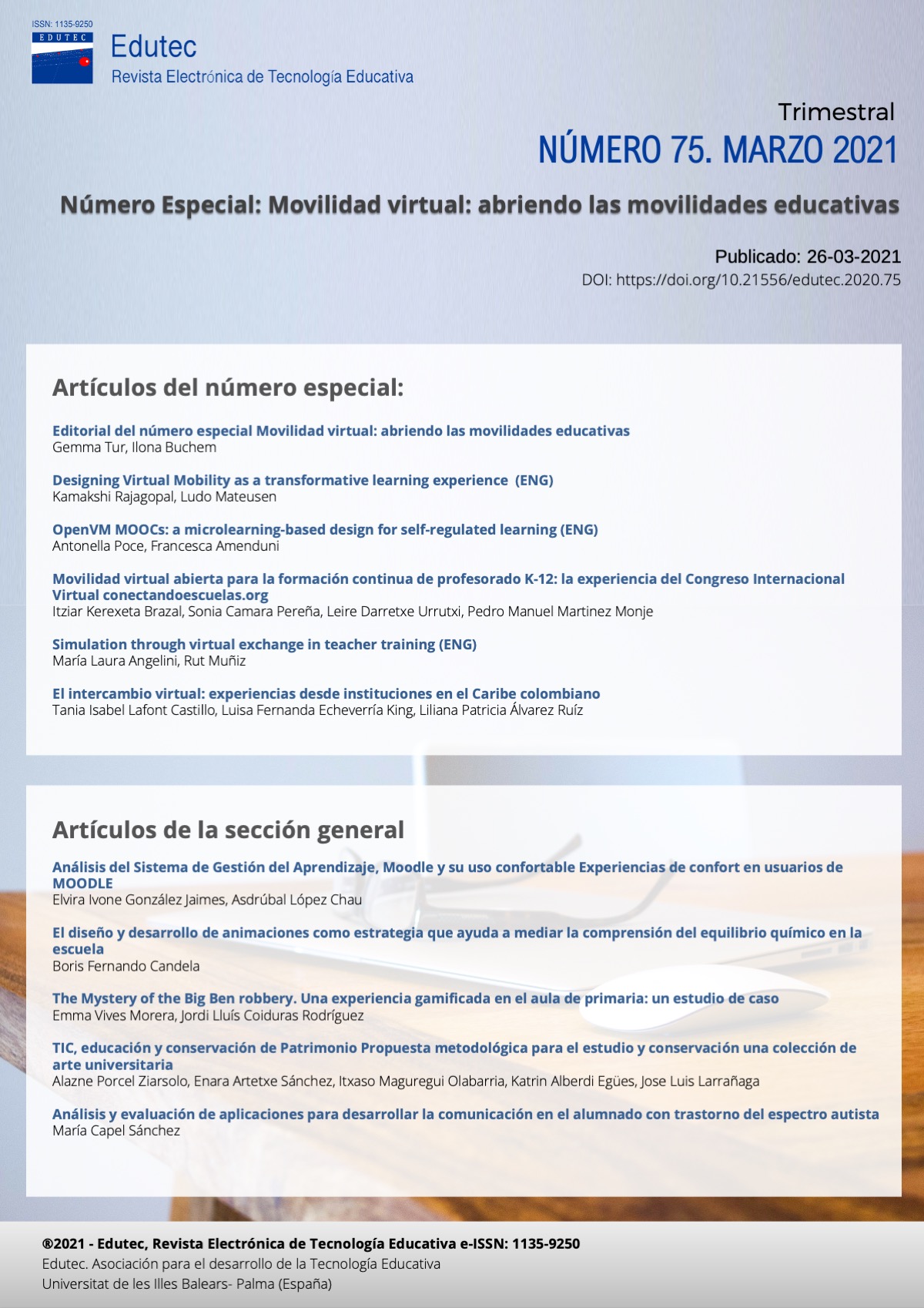Analysis and evaluation of applications focused on developing communication skills in students with autism spectrum disorder
DOI:
https://doi.org/10.21556/edutec.2021.75.1681Keywords:
autism spectrum disorder; apps; communication; quality evaluation; rubricAbstract
Technology is essential to help with the development of communication skills in people who have autism. Currently, there has been a significant increase in the number of applications which turn out to be very interesting for them, however its quality must be identified with proper tools. Therefore, the general purpose of this investigation is to determine the current state of educative technologies' role on the educative intervention in students with autism and analyse and evaluate which software are more adequate to develop their communicative skills.
In this descriptive investigation, 50 educative applications focused on developing communication skills in students with autism are analysed and evaluated. The information and analysis have been carried out by means of a rubric.
Results showed that 8 applications had excellent quality and 17 with a decent score, allowing me to recommend their use in educative interventions. Additionally, an application catalogue has been developed, which may be of use to teachers and families.
Downloads
References
APA (2014). Guía de consulta de los criterios diagnósticos del DSM-5. American Psychiatric Pub.
Bouck, E. C., Satsangi, R. & Flanagan, S. (2016). Focus on Inclusive Education: Evaluating Apps for Students With Disabilities: Supporting Academic Access and Success. Childhood Education, 92(4), 324–328. https://doi.org/10.1080/00094056.2016.1208014
Boyd, T. K., Hart Barnett, J. E. & More, C. M. (2015). Evaluating iPad Technology for Enhancing Communication Skills of Children With Autism Spectrum Disorders. Intervention in School and Clinic, 51(1), 19–27. https://doi.org/10.1177/1053451215577476
Cepeda, O., Gallardo, I.M. y Rodríguez, J. (2017). La evaluación de los materiales didácticos digitales. Revista Latinoamericana de Tecnología Educativa (RELATEC), 16(2), 80-95. https://doi.org/10.17398/1695-288X.16.2.79
García, S., Garrote, D. y Jiménez, S. (2016). Uso de las TIC en el Trastorno de Espectro Autista: aplicaciones. Edmetic, 5(2), 134-157. http://hdl.handle.net/10396/14211
Hardy, C., Ogden, J., Newman, J. & Cooper, S. (2002). Autism and ICT: A guide for teachers and parents. David Fulton.
Hernández-Sampieri, R., Fernández, C. y Baptista, L. (2014). Metodología de la investigación (6ª ed.). McGRAW-HILL.
Higgins, K., Boone, R. & Williams, D. L. (2000). Evaluating Educational Software for Special Education. Intervention in School and Clinic, 36(2), 109 115. https://doi.org/10.1177/105345120003600207
Jiménez, M.D., Serrano, J.L. y Prendes, M.P. (2017). Estudio de caso de la influencia del aprendizaje electrónico móvil en el desarrollo de la comunicación y el lenguaje con un niño con TEA. Educar, 53(2), 419-443. https://doi.org/10.5565/rev/educar.782
Larco, A., Montenegro, C., Diaz, E. & Lujan-Mora, S. (2018). Underlying Quality Factors in Spanish Language Apps for People with Disabilities. 2018 International Conference on eDemocracy & eGovernment (ICEDEG). https://doi.org/10.1109/ICEDEG.2018.8372347
Larco, A., Yanez, C., Almendáriz, V. & Lujan-Mora, S. (2018). Thinking about inclusion: Assessment of multiplatform apps for people with disability. 2018 IEEE Global Engineering Education Conference (EDUCON). https://doi.org/10.1109/educon.2018.8363250
Marquès, P. (1999). Criterios para la clasificación y evaluación de espacios web de interés educativo. Educar, (25), 95-111. https://www.raco.cat/index.php/Educar/article/view/20717
McNaughton, D. & Light, J. (2013). The iPad and Mobile Technology Revolution: Benefits and Challenges for Individuals who require Augmentative and Alternative Communication. Augmentative and Alternative Communication, 29(2), 107-116. https://doi.org/10.3109/07434618.2013.784930
Mehdipour, Y. & Zerehkafi, H. (2013). Mobile Learning for Education: Benefits and Challenges. International Journal of Computational Engineering Research, 3(6), 93-101. http://www.ijceronline.com/papers/Vol3_issue6/part%203/P03630930100.pdf
Montero, G. (2019). Guía para el profesorado. Uso responsable y seguro de las TIC en el alumnado con trastorno del espectro del autismo. Confederación Autismo España.
More, C. M., & Travers, J. C. (2013). What's app with that? Selecting educational apps for young children with disabilities. Young Exceptional Children, 16(2), 15-32. https://doi.org/10.1177/1096250612464763
Ok, M. W., Kim, M. K., Kang, E. Y. & Bryant, B. R. (2015). How to Find Good Apps: An Evaluation Rubric for Instructional Apps for Teaching Students With Learning Disabilities. Intervention in School and Clinic, 51(4), 244–252. https://doi.org/10.1177/1053451215589179
Pastor, C. A., Sánchez, J. M. y Zubillaga, A. (2014). Diseño Universal para el aprendizaje (DUA). https://www.educadua.es/doc/dua/dua_pautas_intro_cv.pdf
Salinas, P. (2012). Metodología de la investigación científica. Universidad de Los Andes.
Sanromà, M., Lázaro, J.L. y Gisbert-Cervera, M. (2017). La tecnología móvil. Una herramienta para la mejora de la inclusión digital de las personas con TEA. Psicología, Conocimiento y Sociedad, 7(2), 227-251. http://www.scielo.edu.uy/pdf/pcs/v7n2/1688-7026-pcs-7-02-00173.pdf
Terrazas, M., Sánchez, S. y Becerra, M.T. (2016). Las TIC como herramienta de apoyo para personas con Trastorno del Espectro Autista (TEA). Revista nacional e internacional de educación inclusiva, 9(2), 102-136. https://dialnet.unirioja.es/servlet/articulo?codigo=5600282
Walker, H. (2010). Evaluation rubric for iPod apps. https://learninginhand.com/blog/evaluation-rubric-for-educational-apps.html
Weng, P.L. & Taber-Doughty, T. (2015). Developing an App Evaluation Rubric for Practitioners in Special Education. Journal of Special Education Technology, 30(1), 43–58. https://doi.org/10.1177/016264341503000104
Wing, L. (1998): El autismo en niños y adultos. Una guía para la familia. Paidós.
Downloads
Published
How to Cite
Issue
Section
License
By submitting the paper, the authors assign the publication rights to the journal Edutec. For its part, Edutec authorises its distribution as long as its content is not altered and its origin is indicated. At the end of each article published in Edutec, the citation procedure is indicated.
The management and editorial board of Edutec Revista Electrónica de Tecnología Educativa do not accept any responsibility for the statements and ideas expressed by the authors in their work.
Translated with www.DeepL.com/Translator (free version)









